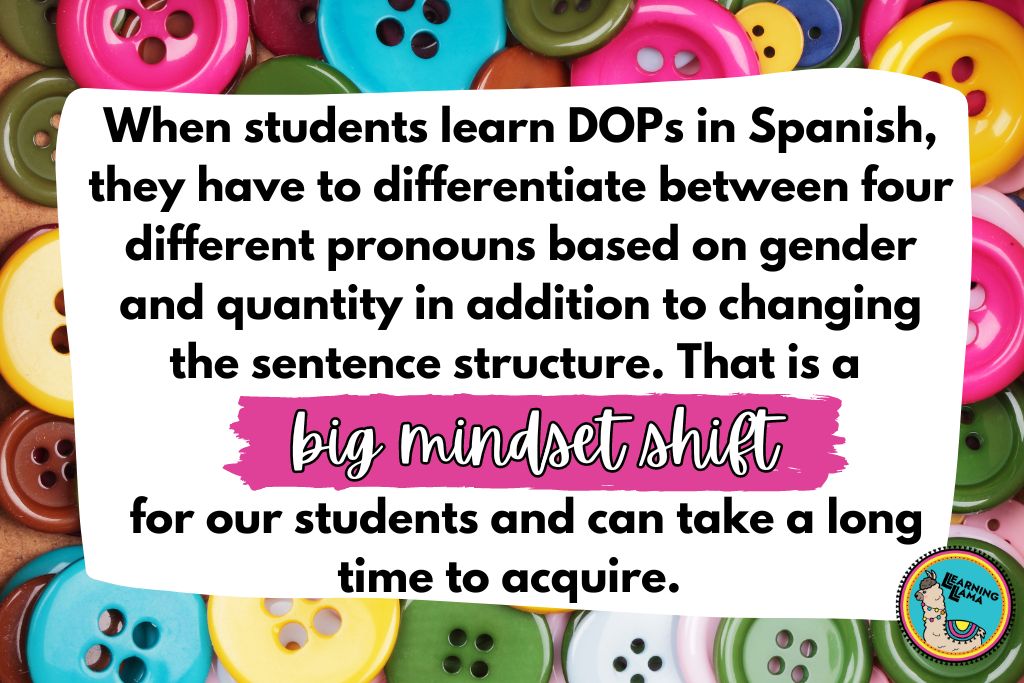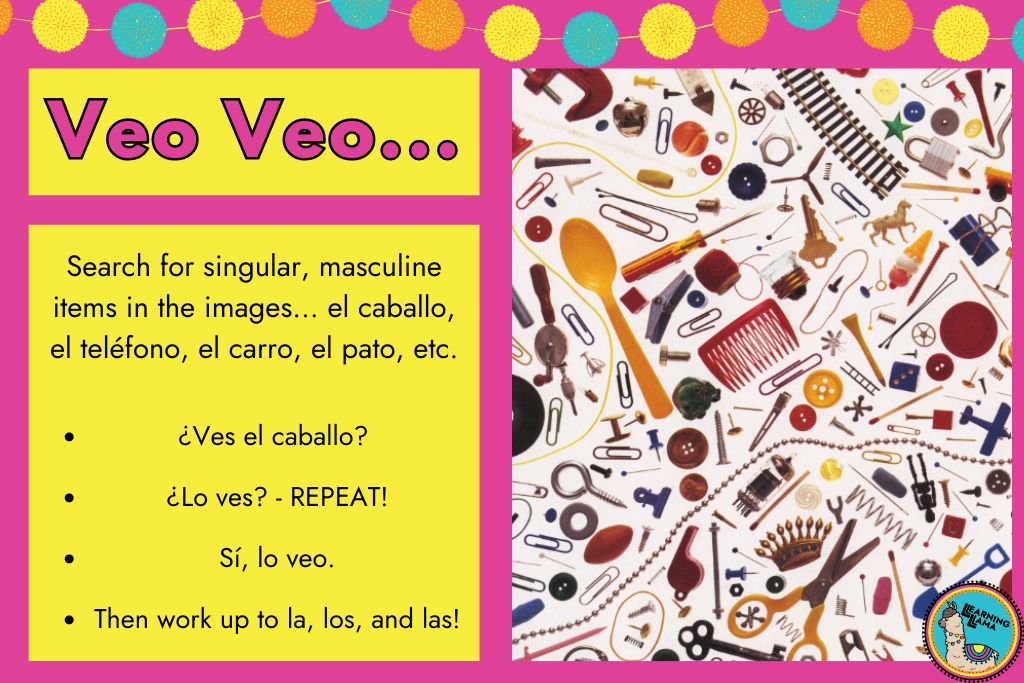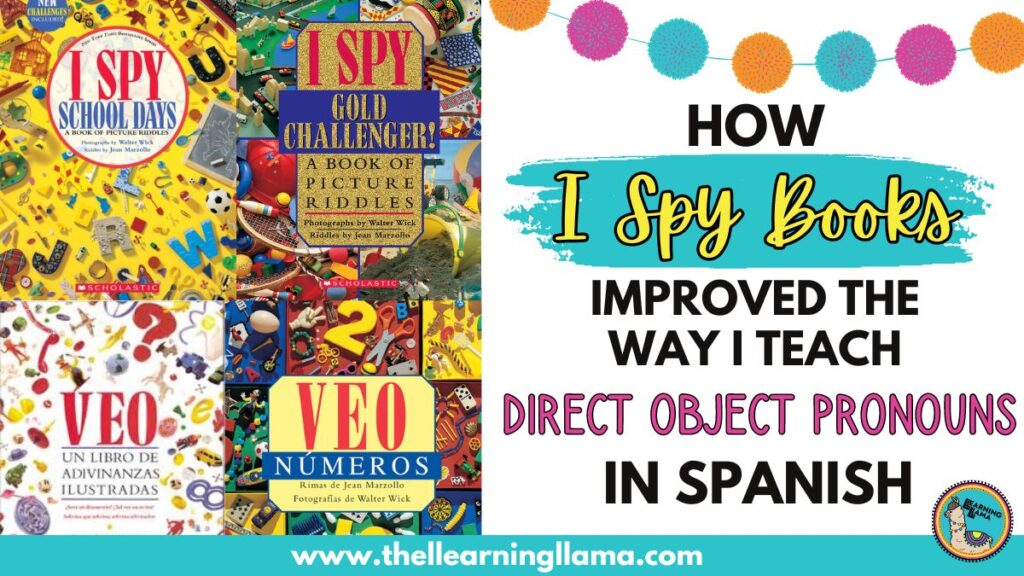I remember the first time I taught direct object pronouns in Spanish 3 Honors. I also incorporated indirect object pronouns. My students left that lesson more confused than when we started. I felt like I failed them. The lesson included wayyyy too much info; I was expecting them to grasp a grammatical concept that was too complex. I knew I had to make a change.
It wasn’t until the following year when I took time to revamp my entire lesson plan on direct object pronouns in Spanish. I don’t like to “focus” on grammar, but this concept was in the curriculum. I needed to find a way to teach it that would take it slow and allow for a ton of repetition. One day, I was looking through books in my closet when I saw an I Spy book, and it just clicked! When we play I Spy, we say, “I see it!” And that one simple phrase is enough to jumpstart a lesson on direct object pronouns.
And let me tell you, the light bulbs went off with this new method of teaching DOPs! That year, my students left the lesson actually being able to use DOPs on Day 1 of the unit. They were laughing, having fun, and learning! From this year on, I always use I Spy books to teach direct object pronouns.
Where Can I Find “I Spy” Books?
You do not need the Spanish versions of the books, although that would be an added bonus. The main purpose of the books is the use of the images. You can create your own list of “I spy” items based on your students’ prior vocabulary!
Below are some of my favorite I Spy books I use with my students. Some I even had during my childhood (and you may have as well), so they hold a special place in my heart. You can use any book during any time of the school year, but if you are studying a specific unit like animals or holidays, you may want to choose a fun themed book.
I usually put my students in small groups and give each group a copy of the book. Multiple copies of the books are helpful, so each group of students has the book to look at together.Some other options would be to give each group a different book, but then they are searching for different items on different pages. If you only have one book, you could set up stations to practice direct object pronouns and one station could be I Spy.
Fortunately, I found I Spy books in Spanish at a Scholastic Warehouse Sale, but ever since the pandemic, Scholastic has not held these sales. You could find books at library sales, GoodWill, book sales, yard sales, and more.Here are my tips for building a classroom library on a budget. If you just want to purchase them immediately and you don’t enjoy going on a hunt for them, here are some of my favorites on Amazon.
- I Spy: A Book of Picture Riddles
- I Spy: School Days
- I Spy: Animals
- I Spy: Christmas
- I Spy: Spooky Nights

Why Do “I Spy” Books Make the BEST Direct Object Pronoun Lesson?
In English, we can simply say “I see it!” or “I see them!”. The word order in the sentences is subject, verb, direct object pronoun. When students learn Spanish, they have to differentiate between four different pronouns based on gender and quantity in addition to changing the sentence structure. That is a big mindset shift for our students and can take a long time to acquire.
When you play “I Spy,” the only phrases you really need are “Do you see IT/THEM?” “Yes, I see IT/THEM.” It is straight direct object pronoun practice in an authentic and fun way! There are no frills and extra fluff – they will practice these phrases over and over while having fun.

My Tips for Using I Spy Books with Direct Object Pronouns in Spanish
Practice with the same direct object pronouns in Spanish over and over again. It is probably easiest to start with “lo.” This means, have your students search for singular, masculine items in the images… el caballo, el teléfono, el carro, el pato, etc. They will get used to hearing and saying “¿Lo ves?” “Sí, lo veo.” You will need to start with the noun “el caballo,” by asking “¿Ves el caballo?,” then quickly switch to “¿Lo ves?” and repeat yourself over and over again… aloud to the class, as you circulate to each small group, and even to individual students. Let them hear you ask it again and again. Let them hear each other respond “Sí, lo veo,” multiple times. Repetition is key here.
The simple change in sentence structure is enough to confuse your students that when we add other options like la, los, and las, it becomes too much. After a few rounds or even a day of practice with “lo,” then add in the other pronouns. Judge it based on how well your students seem to be acquiring this new sentence structure. Then, go from there. If they need more time, have them come up with items in the image or around the room that are singular and masculine. Then, they ask their classmates if they see it.

Children’s Books for Grammar
I find that when teaching grammar, children’s books are one of the most authentic resources to make grammar learning less of a chore and more of a natural acquisition of structures. There are countless other grammatical features that can be taught using children’s books, like the future or conditional tense with stories such as If You Give a Mouse a Cookie. In this blog post, you’ll find specific children’s books for different grammatical features.
And for direct object pronouns, try Huevos verdes con jamón… a story your students know by heart, so hearing the different sentence structure will be really helpful!
Simply by using I Spy books, I drastically improved the success of my direct object pronoun lessons in Spanish class. Remember that less is more, and when you are introducing a complex topic or structure, repetition is key for natural acquisition – and by playing I Spy with this method, your students are sure to get it!





